We at Crack4sure are committed to giving students who are preparing for the Google Professional-Cloud-Architect Exam the most current and reliable questions . To help people study, we've made some of our Google Certified Professional - Cloud Architect (GCP) exam materials available for free to everyone. You can take the Free Professional-Cloud-Architect Practice Test as many times as you want. The answers to the practice questions are given, and each answer is explained.
For this question, refer to the JencoMart case study.
JencoMart wants to move their User Profiles database to Google Cloud Platform. Which Google Database should they use?
For this question, refer to the JencoMart case study.
JencoMart has built a version of their application on Google Cloud Platform that serves traffic to Asia. You want to measure success against their business and technical goals. Which metrics should you track?
For this question, refer to the JencoMart case study.
JencoMart has decided to migrate user profile storage to Google Cloud Datastore and the application servers to Google Compute Engine (GCE). During the migration, the existing infrastructure will need access to Datastore to upload the data. What service account key-management strategy should you recommend?
For this question, refer to the JencoMart case study.
The migration of JencoMart’s application to Google Cloud Platform (GCP) is progressing too slowly. The infrastructure is shown in the diagram. You want to maximize throughput. What are three potential bottlenecks? (Choose 3 answers.)
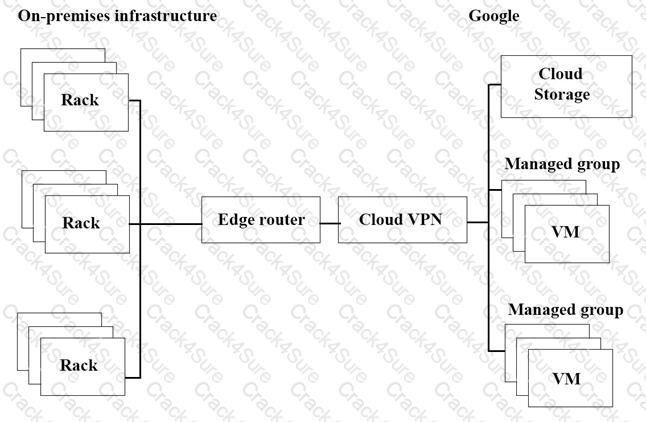
For this question, refer to the JencoMart case study.
The JencoMart security team requires that all Google Cloud Platform infrastructure is deployed using a least privilege model with separation of duties for administration between production and development resources. What Google domain and project structure should you recommend?
For this question, refer to the TerramEarth case study.
The TerramEarth development team wants to create an API to meet the company's business requirements. You want the development team to focus their development effort on business value versus creating a custom framework. Which method should they use?
For this question, refer to the TerramEarth case study.
TerramEarth plans to connect all 20 million vehicles in the field to the cloud. This increases the volume to 20 million 600 byte records a second for 40 TB an hour. How should you design the data ingestion?
For this question, refer to the TerramEarth case study.
TerramEarth has equipped unconnected trucks with servers and sensors to collet telemetry data. Next year they want to use the data to train machine learning models. They want to store this data in the cloud while reducing costs. What should they do?
For this question refer to the TerramEarth case study.
Which of TerramEarth's legacy enterprise processes will experience significant change as a result of increased Google Cloud Platform adoption.
Your agricultural division is experimenting with fully autonomous vehicles.
You want your architecture to promote strong security during vehicle operation.
Which two architecture should you consider?
Choose 2 answers:
For this question, refer to the TerramEarth case study
Your development team has created a structured API to retrieve vehicle data. They want to allow third parties to develop tools for dealerships that use this vehicle event data. You want to support delegated authorization against this data. What should you do?
For this question, refer to the TerramEarth case study.
TerramEarth's 20 million vehicles are scattered around the world. Based on the vehicle's location its telemetry data is stored in a Google Cloud Storage (GCS) regional bucket (US. Europe, or Asia). The CTO has asked you to run a report on the raw telemetry data to determine why vehicles are breaking down after 100 K miles. You want to run this job on all the data. What is the most cost-effective way to run this job?
You have an application that makes HTTP requests to Cloud Storage. Occasionally the requests fail with
HTTP status codes of 5xx and 429.
How should you handle these types of errors?
For this question, refer to the TerramEarth case study.
TerramEarth's CTO wants to use the raw data from connected vehicles to help identify approximately when a vehicle in the development team to focus their failure. You want to allow analysts to centrally query the vehicle data. Which architecture should you recommend?
A)
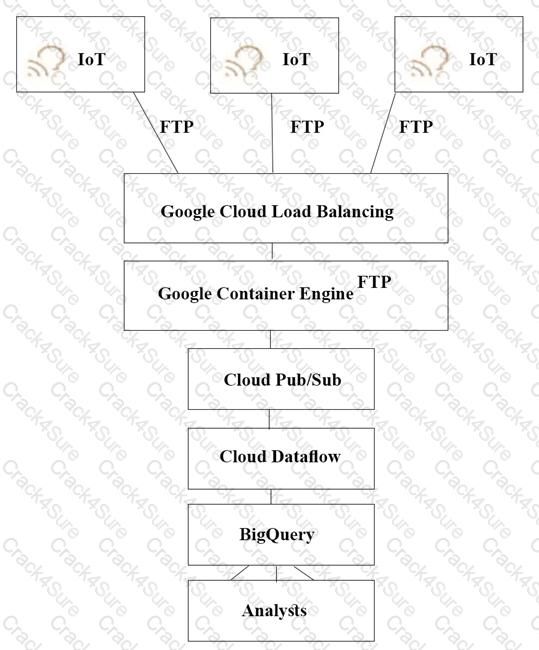
B)
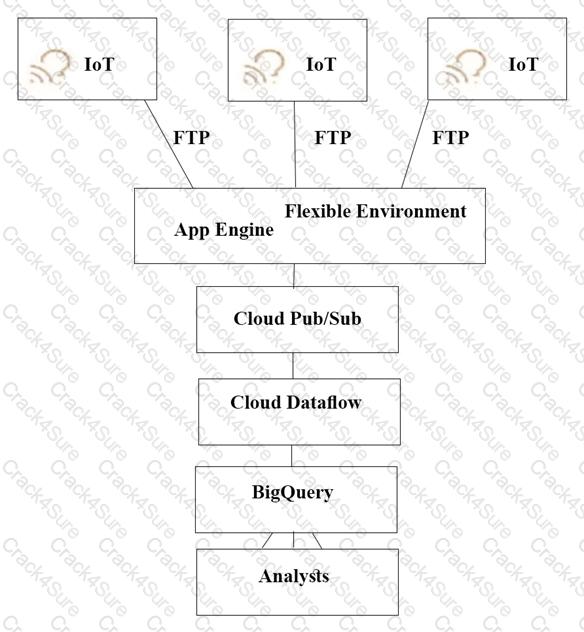
C)
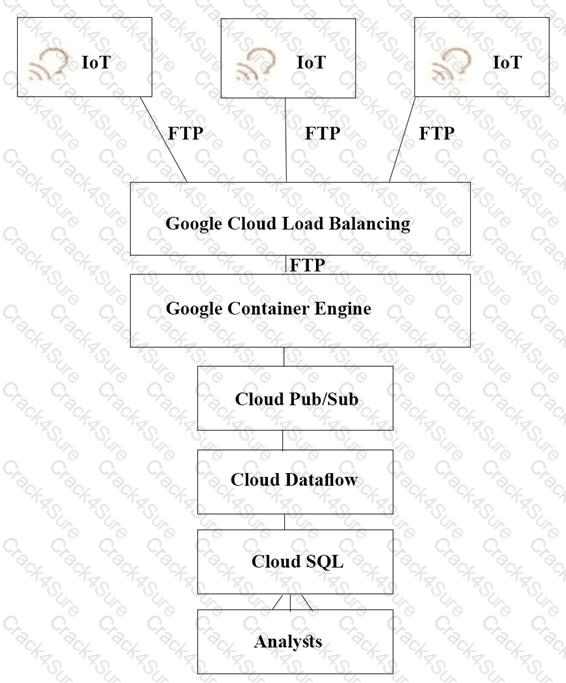
D)
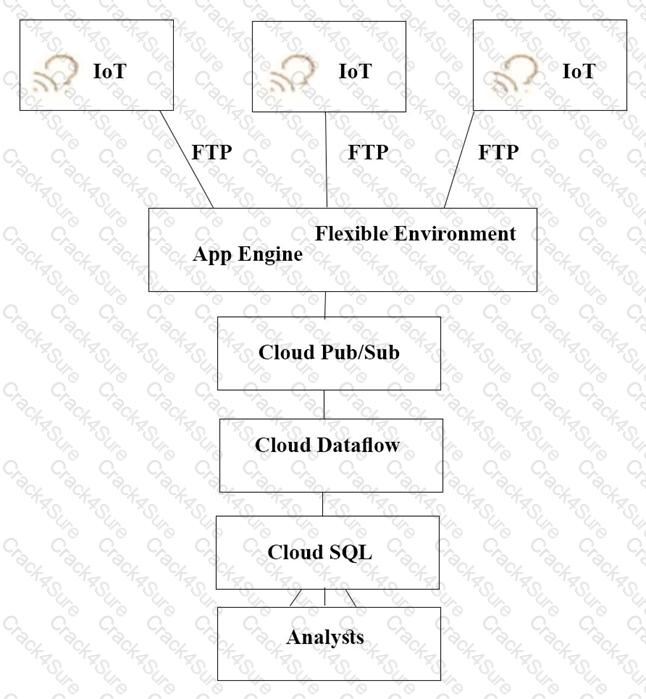
You are implementing Firestore for Mountkirk Games. Mountkirk Games wants to give a new game
programmatic access to a legacy game's Firestore database. Access should be as restricted as possible. What
should you do?
Your development team has created a mobile game app. You want to test the new mobile app on Android and
iOS devices with a variety of configurations. You need to ensure that testing is efficient and cost-effective. What
should you do?
For this question, refer to the TerramEarth case study.
To speed up data retrieval, more vehicles will be upgraded to cellular connections and be able to transmit data to the ETL process. The current FTP process is error-prone and restarts the data transfer from the start of the file when connections fail, which happens often. You want to improve the reliability of the solution and minimize data transfer time on the cellular connections. What should you do?
For this question, refer to the Mountkirk Games case study. You are in charge of the new Game Backend Platform architecture. The game communicates with the backend over a REST API.
You want to follow Google-recommended practices. How should you design the backend?
For this question, refer to the Mountkirk Games case study.
Mountkirk Games wants to set up a continuous delivery pipeline. Their architecture includes many small services that they want to be able to update and roll back quickly. Mountkirk Games has the following requirements:
• Services are deployed redundantly across multiple regions in the US and Europe.
• Only frontend services are exposed on the public internet.
• They can provide a single frontend IP for their fleet of services.
• Deployment artifacts are immutable.
Which set of products should they use?
You have a Compute Engine application that you want to autoscale when total memory usage exceeds 80%. You have Installed the Cloud Ops agent and configured the autoscaling policy as follows:

You observe that the application does not scale under high load. You want to resolve this. What should you do?
For this question, refer to the Mountkirk Games case study.
Mountkirk Games wants you to design their new testing strategy. How should the test coverage differ from their existing backends on the other platforms?
For this question, refer to the Mountkirk Games case study.
Mountkirk Games wants to set up a real-time analytics platform for their new game. The new platform must meet their technical requirements. Which combination of Google technologies will meet all of their requirements?
For this question, refer to the Mountkirk Games case study.
Mountkirk Games' gaming servers are not automatically scaling properly. Last month, they rolled out a new feature, which suddenly became very popular. A record number of users are trying to use the service, but many of them are getting 503 errors and very slow response times. What should they investigate first?
You are working in a highly secured environment where public Internet access from the Compute Engine VMs is not allowed. You do not yet have a VPN connection to access an on-premises file server. You need to install specific software on a Compute Engine instance. How should you install the software?
For this question, refer to the Mountkirk Games case study.
Mountkirk Games has deployed their new backend on Google Cloud Platform (GCP). You want to create a thorough testing process for new versions of the backend before they are released to the public. You want the testing environment to scale in an economical way. How should you design the process?
For this question, refer to the Mountkirk Games case study
Mountkirk Games needs to create a repeatable and configurable mechanism for deploying isolated application environments. Developers and testers can access each other's environments and resources, but they cannot access staging or production resources. The staging environment needs access to some services from production.
What should you do to isolate development environments from staging and production?
For this question, refer to the Helicopter Racing League (HRL) case study. Recently HRL started a new regional
racing league in Cape Town, South Africa. In an effort to give customers in Cape Town a better user
experience, HRL has partnered with the Content Delivery Network provider, Fastly. HRL needs to allow traffic
coming from all of the Fastly IP address ranges into their Virtual Private Cloud network (VPC network). You are
a member of the HRL security team and you need to configure the update that will allow only the Fastly IP
address ranges through the External HTTP(S) load balancer. Which command should you use?
For this question, refer to the EHR Healthcare case study. You need to define the technical architecture for securely deploying workloads to Google Cloud. You also need to ensure that only verified containers are deployed using Google Cloud services. What should you do? (Choose two.)
For this question, refer to the EHR Healthcare case study. You are responsible for ensuring that EHR's use of Google Cloud will pass an upcoming privacy compliance audit. What should you do? (Choose two.)
For this question, refer to the EHR Healthcare case study. EHR has single Dedicated Interconnect
connection between their primary data center and Googles network. This connection satisfies
EHR’s network and security policies:
• On-premises servers without public IP addresses need to connect to cloud resources
without public IP addresses
• Traffic flows from production network mgmt. servers to Compute Engine virtual
machines should never traverse the public internet.
You need to upgrade the EHR connection to comply with their requirements. The new
connection design must support business critical needs and meet the same network and
security policy requirements. What should you do?
For this question, refer to the EHR Healthcare case study. In the past, configuration errors put public IP addresses on backend servers that should not have been accessible from the Internet. You need to ensure that no one can put external IP addresses on backend Compute Engine instances and that external IP addresses can only be configured on frontend Compute Engine instances. What should you do?
For this question, refer to the EHR Healthcare case study. You are a developer on the EHR customer portal team. Your team recently migrated the customer portal application to Google Cloud. The load has increased on the application servers, and now the application is logging many timeout errors. You recently incorporated Pub/Sub into the application architecture, and the application is not logging any Pub/Sub publishing errors. You want to improve publishing latency. What should you do?
You need to upgrade the EHR connection to comply with their requirements. The new connection design must support business-critical needs and meet the same network and security policy requirements. What should you do?
For this question, refer to the EHR Healthcare case study. You need to define the technical architecture for hybrid connectivity between EHR's on-premises systems and Google Cloud. You want to follow Google's recommended practices for production-level applications. Considering the EHR Healthcare business and technical requirements, what should you do?
For this question, refer to the EHR Healthcare case study. You are responsible for designing the Google Cloud network architecture for Google Kubernetes Engine. You want to follow Google best practices. Considering the EHR Healthcare business and technical requirements, what should you do to reduce the attack surface?
For this question, refer to the Dress4Win case study.
As part of Dress4Win's plans to migrate to the cloud, they want to be able to set up a managed logging and monitoring system so they can handle spikes in their traffic load. They want to ensure that:
• The infrastructure can be notified when it needs to scale up and down to handle the ebb and flow of usage throughout the day
• Their administrators are notified automatically when their application reports errors.
• They can filter their aggregated logs down in order to debug one piece of the application across many hosts
Which Google StackDriver features should they use?
For this question, refer to the Dress4Win case study.
Dress4Win has configured a new uptime check with Google Stackdriver for several of their legacy services. The Stackdriver dashboard is not reporting the services as healthy. What should they do?
For this question, refer to the Dress4Win case study.
As part of their new application experience, Dress4Wm allows customers to upload images of themselves. The customer has exclusive control over who may view these images. Customers should be able to upload images with minimal latency and also be shown their images quickly on the main application page when they log in. Which configuration should Dress4Win use?
For this question, refer to the Dress4Win case study.
Dress4Win has asked you for advice on how to migrate their on-premises MySQL deployment to the cloud. They want to minimize downtime and performance impact to their on-premises solution during the migration. Which approach should you recommend?
For this question, refer to the Dress4Win case study.
The Dress4Win security team has disabled external SSH access into production virtual machines (VMs) on Google Cloud Platform (GCP). The operations team needs to remotely manage the VMs, build and push Docker containers, and manage Google Cloud Storage objects. What can they do?
For this question, refer to the Dress4Win case study.
At Dress4Win, an operations engineer wants to create a tow-cost solution to remotely archive copies of database backup files. The database files are compressed tar files stored in their current data center. How should he proceed?
Dress4win has end to end tests covering 100% of their endpoints.
They want to ensure that the move of cloud does not introduce any new bugs.
Which additional testing methods should the developers employ to prevent an outage?
For this question, refer to the Dress4Win case study.
You want to ensure Dress4Win's sales and tax records remain available for infrequent viewing by auditors for at least 10 years. Cost optimization is your top priority. Which cloud services should you choose?
For this question, refer to the Dress4Win case study.
Dress4Win has asked you to recommend machine types they should deploy their application servers to. How should you proceed?
You are managing several internal applications that are deployed on Compute Engine. Business users inform you that an application has become very slow over the past few days. You want to find the underlying cause in order to solve the problem. What should you do first?
Your company has just recently activated Cloud Identity to manage users. The Google Cloud Organization has been configured as wed. The security learn needs to secure protects that will be part of the Organization. They want to prohibit IAM users outside the domain from gaining permissions from now on. What should they do?
You need to evaluate your team readiness for a new GCP project. You must perform the evaluation and create a skills gap plan incorporates the business goal of cost optimization. Your team has deployed two GCP projects successfully to date. What should you do?
Your company has an enterprise application running on Compute Engine that requires high availability and high performance. The application has been deployed on two instances in two zones in the same region m active passive mode. The application writes data to a persistent disk in the case of a single zone outage that data should be immediately made available to the other instance in the other zone. You want to maximize performance while minimizing downtime and data loss. What should you do?
Your company is developing a web-based application. You need to make sure that production deployments are linked to source code commits and are fully auditable. What should you do?
For this question, refer to the Dress4Win case study. You want to ensure that your on-premises architecture meets business requirements before you migrate your solution.
What change in the on-premises architecture should you make?
For this question, refer to the Dress4Win case study. Considering the given business requirements, how would you automate the deployment of web and transactional data layers?
For this question, refer to the Dress4Win case study. To be legally compliant during an audit, Dress4Win must be able to give insights in all administrative actions that modify the configuration or metadata of resources on Google Cloud.
What should you do?
For this question, refer to the Dress4Win case study. You are responsible for the security of data stored in
Cloud Storage for your company, Dress4Win. You have already created a set of Google Groups and assigned the appropriate users to those groups. You should use Google best practices and implement the simplest design to meet the requirements.
Considering Dress4Win’s business and technical requirements, what should you do?
For this question, refer to the Dress4Win case study. Which of the compute services should be migrated as –is and would still be an optimized architecture for performance in the cloud?
For this question, refer to the Dress4Win case study. Dress4Win is expected to grow to 10 times its size in 1 year with a corresponding growth in data and traffic that mirrors the existing patterns of usage. The CIO has set the target of migrating production infrastructure to the cloud within the next 6 months. How will you configure the solution to scale for this growth without making major application changes and still maximize the ROI?
3 Months Free Update
3 Months Free Update
3 Months Free Update